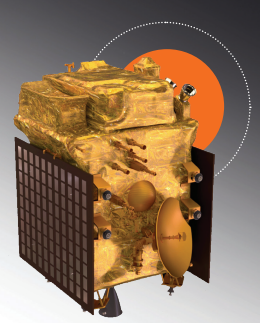Dr Arun Prakash
Our solar system’s vibrant heart, the Sun, is a mesmerizing ball of blazing gases that has held humanity’s curiosity for ages. Now, India’s space agency, ISRO, is embarking on a groundbreaking mission to unveil the Sun’s secrets like never before. Named Aditya L1, this mission is set to launch in September 02, 2023, promising a treasure trove of insights into the fiery star that gives us life and energy.
The Sun: Our Eternal Light Source
Picture a massive, glowing sphere of hydrogen and helium gases – that’s the Sun. Its radiant energy fuels our entire solar system, and without it, life on Earth wouldn’t exist. For over 4.5 billion years, the Sun has illuminated the cosmos. At its core, temperatures soar to a staggering 15 million degrees Celsius, igniting a process called nuclear fusion that powers its brilliance.
Why Study the Sun?
The Sun isn’t just a cosmic lamp; it’s a dynamic entity with eruptions and energy releases that can impact our technology and even space travel. Exploring the Sun allows us to understand its behavior, which in turn helps us safeguard our spacecraft and communication systems from solar disturbances. Additionally, learning about the Sun’s activities can protect astronauts from harmful solar phenomena. This research is like peeking into nature’s laboratory, where we can witness extreme phenomena we can’t replicate on Earth.
The Space Weather Connection
Imagine the Sun as a master conductor, showering Earth with radiation, heat, particles, and magnetic fields. This celestial symphony can create what’s known as “space weather,” affecting our technological systems. Think of it as a space-based weather forecast that helps us predict and prepare for solar storms and their potential disruptions.
Meet Aditya L1: The Sun Whisperer

Aditya L1 is a trailblazing Indian solar mission poised to revolutionize our understanding of the Sun. It will nestle in a strategic orbit around a point called Lagrangian L1, about 1.5 million kilometers from Earth. This position grants Aditya L1 a constant view of the Sun, a boon for uninterrupted observations. Equipped with seven scientific tools, or payloads, the mission will scrutinize the Sun’s various layers, from its photosphere to its fiery corona.
What Aditya L1 Aims to Achieve
Aditya L1 holds the key to unraveling some of the Sun’s most enigmatic phenomena. Its science objectives include understanding the mechanisms behind solar wind acceleration and coronal heating. It aims to decode the initiation of solar flares and Coronal Mass Ejections (CMEs), which can impact space weather around Earth. The mission will also delve into the intricate dynamics of the Sun’s atmosphere and the distribution of solar wind particles.
The Pioneering Payloads of Aditya L1
The seven scientific payloads aboard Aditya L1 are ingeniously designed to capture different aspects of the Sun’s behavior. The Visible Emission Line Coronagraph (VELC) will observe the corona and Coronal Mass Ejections, while the Solar Ultra-violet Imaging Telescope (SUIT) will provide UV images of the photosphere and chromosphere. The Aditya Solar wind Particle EXperiment (ASPEX) and Plasma Analyser Package for Aditya (PAPA) will analyze solar wind and energetic ions. The mission also includes X-ray spectrometers to study solar flares and a magnetometer to measure interplanetary magnetic fields.
The Dance of Lagrange Points

Aditya L1’s strategic orbit at Lagrangian L1 is a celestial sweet spot where gravitational forces create an equilibrium. It allows the spacecraft to “hover” in position, making it ideal for extended observations of the Sun without interruptions.
A Glimpse of the Future
Aditya L1 will be launched using ISRO’s PSLV rocket from Sriharikota. After traveling for about four months, it will settle into its Lagrange orbit. This mission is the next step in humanity’s ongoing quest to understand the Sun’s intricacies and its profound influence on our lives.
Studying the Sun Beyond Earth
Why send a spacecraft to study the Sun from space when we have powerful instruments on Earth? Earth’s atmosphere and magnetic field shield us from many of the Sun’s emissions, so observing from space allows us to capture the full spectrum of its radiations. Studying how solar particles travel through interplanetary space requires a vantage point far from Earth’s magnetic influence, and Lagrange points provide that unique perch.
Aditya L1: A Step Toward Understanding
While Aditya L1 is a monumental leap in solar exploration, it’s not the final chapter. The Sun’s complexity demands diverse perspectives, which can only be achieved through multiple missions and observations. Scientists dream of studying the Sun from different viewpoints, like the unexplored L5 Lagrange point or even sending spacecraft to examine the Sun’s poles, where its magnetic fields govern its activity and influence solar cycles.
In the ever-evolving quest to comprehend the Sun’s essence, Aditya L1 is a shining example of human ingenuity and determination. As this mission soars into space, it carries the aspirations of students, scientists, and the general public alike, united by the desire to uncover the Sun’s hidden stories and the role it plays in shaping our cosmic neighborhood.
Source : Aditya – L1: Mission Booklet, ISRO